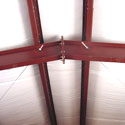Heat Transfer and Thermal Values
|
Heat Transfer |
Effectively controlling temperature in a steel building requires insulation to be present along exterior walls and roof. When a temperature differential is present in an enclosed steel building, heat will work from warmer areas to colder areas until the temperature in the building has stabilized. At the point of thermal stabilization, the cooler (and heavier) air will be present at lower elevations and warmer air will be present at the roofline. The function of insulation is to help stabilize air temperature at more desirable levels. When it is hot outside, preventing heat from transferring into the building is the goal, and of course in the winter we want heat to remain inside.
|
Heat transfer occurs in three ways:
|
Conduction : Occurs in a solid or liquid when heat from one object is transferred by touch to another object. An example of this occurs when a pot on a stove will heat up by conductive heat transfer from an electric coil.
|
 |
Convection : Occurs with the physical movement of air. There are two types of convectional heat movement. The first is natural, where hot air rises displacing the cold air and moving it down. The second type is forced or mechanical convection. This occurs when an object, like a fan, physically moves or "forces" the air to move.
|
Radiation : Occurs when an object is warmer or hotter than the air around it. For example, the sun, which is hotter than everything around it, radiates heat waves that travel through the air and is either absorbed by or reflected by the surface it comes in contact with.
|
|
Insulating Against Radiant Heat |
| Traditional forms of mass insulation, like fiberglass, are effective in preventing heat transfer by conduction and convection, but they less effect on radiant heat. Between 80 and 90% of the radiant heat striking fiberglass will pass through or be "emitted". Radiant transfer typically has as much impact on the temperature in a building as conduction and convection. For more information on radiant barrier facings click here. |